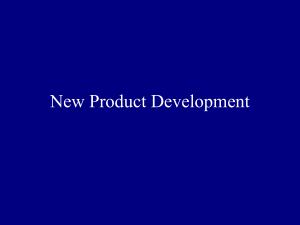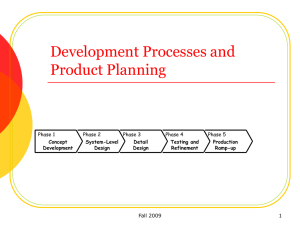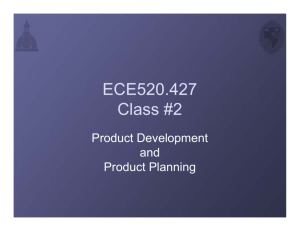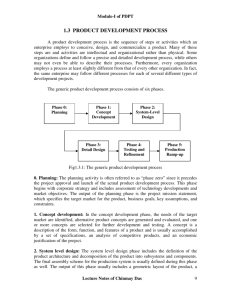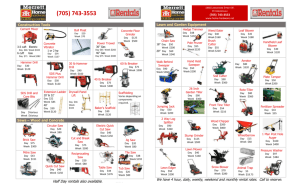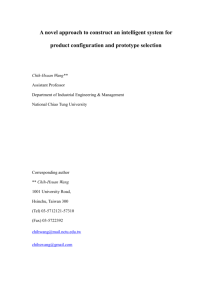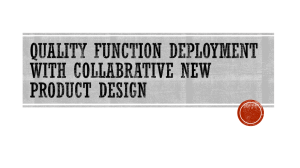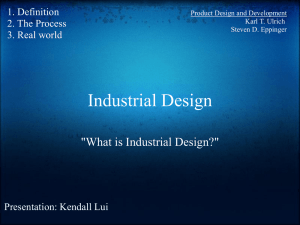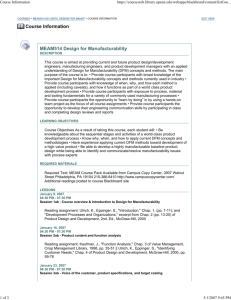Collaborative Product Development MGT 6326
advertisement
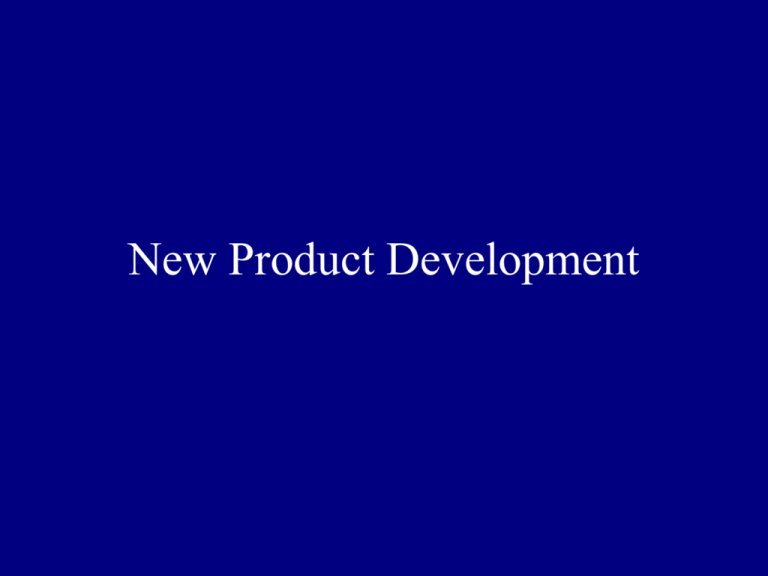
New Product Development Some products… What is product development all about? “Product development is the set of activities beginning with the perception of a market opportunity and ending in the production, sale, and delivery of the product” Ulrich & Eppinger, 2002 Market issues… “Rather than compete with the super jumbo (a 550-seat cruiser by Airbus), Boeing has decided to concentrate on a smaller, faster ‘sonic cruiser’. So the petty snipping of old has been replaced by a genuine battle of philosophies: on one side is size, on the other speed” The Economist, July 2001 Technical issues… … “advance fuel cell-vehicles, could have a profound effect on vehicle manufacturing - perhaps setting the stage for the reinvention of the automobile business. One of the biggest hurdles is the development of safe and effective on-board hydrogen storage.” L. D. Burns Vice President of R&D, General Motors Resource issues… “AstraZeneca has to rein in some of its most promising drug candidates because of lack of resources to develop them simultaneously” Claes Wilhelmsson Head of R&D, AstraZeneca Characteristics of Successful Product Development • Product quality – How good is the product? • Product cost – What is the capital equipment cost and unit production cost? • Development time – How quickly did the team complete the effort? • Development cost – How much did the firm have to spend to develop the product? • Development capability – Are the team and firm better able to develop other products? Challenges of Product Development • Trade-offs – Lightweight vs costly • Dynamics – Technologies, customer tastes, competition change environment • Details – Screws vs snap fits on enclosure of computer • Time pressure – Decisions made quickly and without complete information • Economics – Large investment – will it pay off? • Organizational realities – Team composition, empowerment, functional allegiance, resources Product Development Strategy Task: Define a well-defined product development process and propose a product development organization that will allow your company to compete effectively over the next decade. • Is there a standard development process that will work for every company? • What milestones will be used to divide the overall product development process into phases? • What role do experts from different functional areas play in the development process? • Should the development organization be divided into groups corresponding to projects or to development functions? Product Development Process Phase 0 Phase 1 Phase 2 Phase 3 Phase 4 Phase 5 Planning Concept Development System-level Design Detail Design Testing and Refinement Production Ramp-Up Ulrich and Eppinger 2004 Generate mission statement (target market, business goals, key assumptions and constraints) Example Mission: “design a better hand-held roofing nailer” Assumptions: The nailer will use nails (as opposed to adhesives, screws, etc.) The nailer will be compatible with nail magazines on existing tools The nailer will nail through roofing singles into wood The nailer will be handheld. Product Development Process Phase 0 Phase 1 Phase 2 Phase 3 Phase 4 Phase 5 Planning Concept Development System-level Design Detail Design Testing and Refinement Production Ramp-Up Identify needs of target market; Select several product concepts for further development and testing Ulrich and Eppinger 2004 Example Needs of target market: The nailer inserts nails in rapid succession. The nailer is lightweight. The nailer has no noticeable nailing delay after starting tool. Product concepts: Rotary motor with spring and single impact Rotary motor with spring and multiple impacts Linear motor with a moving mass and single impact Product Development Process Phase 0 Phase 1 Phase 2 Phase 3 Phase 4 Phase 5 Planning Concept Development System-level Design Detail Design Testing and Refinement Production Ramp-Up Define product architecture Decompose product into subsystems and components Define final assembly scheme Ulrich and Eppinger 2004 Product Development Process Phase 0 Phase 1 Phase 2 Phase 3 Phase 4 Phase 5 Planning Concept Development System-level Design Detail Design Testing and Refinement Production Ramp-Up Complete specification of geometry, materials and tolerances of all parts List of standard parts to be purchased Detailed drawings Process plans for fabrication and assembly Ulrich and Eppinger 2004 Product Development Process Phase 0 Phase 1 Phase 2 Phase 3 Phase 4 Phase 5 Planning Concept Development System-level Design Detail Design Testing and Refinement Production Ramp-Up Building of alpha- and beta- prototypes alpha: same material and geometry - does it work? - does it satisfy customer needs? beta: parts supplied by production process - tested internally and by customers - tested for performance and reliability Product Development Process Phase 0 Phase 1 Phase 2 Phase 3 Phase 4 Phase 5 Planning Concept Development System-level Design Detail Design Testing and Refinement Production Ramp-Up Small volume production to train workforce and work out any remaining problems. Finally… LAUNCH!! Variations to Product Development Process • Market pull products – Market opportunity to technology, e.g. sporting goods, furniture – Uses generic process • Technology push products – Technology to market opportunity, e.g. teflon, gore-tex – Concept development takes technology as given • Platform products – Built around existing platform, e.g. consumer electronics, printers – Concept development assumes proven technology platform • Process intensive products – Product constrained by production process, e.g. semiconductors, chemicals – Product and process developed from start • Quick build products – Rapid modeling and prototyping, e.g. software, cell phones – Many design-build-test cycles • Complex systems – System includes many subsystems and components, e.g. airplanes, jet engines – System and subsystems developed by many teams working in parallel Cost and Duration of NPD Projects Cost and Duration of NPD Projects Stanley Tools Jobmaster Screwdriver Annual Production volume Sales lifetime Sales price Number of unique parts Development time Internal development team (peak size) External development team (peak size) Development cost Rollerblade InLine Skate HP DeskJet Printer VW New Beetle Automobile Boeing 777 Airplane Cost and Duration of NPD Projects Stanley Tools Jobmaster Screwdriver Rollerblade InLine Skate HP DeskJet Printer VW New Beetle Automobile Boeing 777 Airplane Annual Production volume 100,000/year 100,000/year 4M/year 100,000/year 50/year Sales lifetime 40 years 3 years 2 years 6 years 30 years Sales price $3 $200 $300 $17000 $130M Number of unique parts 3 35 200 10,000 130,000 Development time 1 year 2 years 1.5 years 3.5 years 4.5 years Internal development team (peak size) 3 people 5 people 100 people 800 people 6800 people External development team (peak size) 3 people 10 people 75 people 800 people 10,000 people Development cost $150,000 $750,000 $50M $400M $3B Cost and Duration of NPD Projects • Plot development cost against the other rows and see if there is any correlation. Why or why not? What drives product development costs? development cost 3500000000 3000000000 2500000000 2000000000 1500000000 1000000000 500000000 0 -20000 0 -500000000 20000 40000 60000 80000 100000 120000 140000 # parts What drives product development costs? development cost 3500000000 3000000000 2500000000 2000000000 1500000000 1000000000 500000000 0 -500000000 0 2000 4000 6000 8000 10000 Internal team size x duration What drives product development costs? development cost 3500000000 3000000000 2500000000 2000000000 1500000000 1000000000 500000000 0 -20000 0 -500000000 20000 40000 60000 80000 Total team size x duration What drives product development costs? Design Changes over Time Quality Function Deployment • A method to translate customer requirements into engineering specifications • Aims to get design, engineering and production people involved early on in the process Quality Function Deployment Quality Function Deployment (QFD) Quality Function Deployment (QFD) Quality Function Deployment (QFD) Quality Function Deployment (QFD) Quality Function Deployment (QFD) Who is Involved in Product Development? • Marketing – – – – – Mediates interactions between firm and customers Identifies product opportunities Defines market segments Identifies customer needs Oversees launch and promotion of product • Design – Lead role in defining physical form of product to best meet customer needs – Includes engineering design and industrial design • Manufacturing and supply chain – Designs and operates the supply chain in order to produce the product from procurement to distribution Organizational challenges • How should the product development team operate? Project-Based Organization Marketing Project Manager Engineering Operations Project 1 Project Managers have more power “Heavy Weight” Project Manager Project Manager Project 2 Functional-Based Organization Marketing manager Engineering Operations manager Project 1 Project 1 Project 1 Project 2 Project 2 Project 2 Project 3 Project 3 Project 4 Functional managers have more power Matrix Organization Project Manager Project 1 Project Manager Marketing manager Project 2 R&D manager Engineering Pros and cons Functional Matrix Project Strength Fosters specialization and expertise Provides integration Optimal resource and speed benefits allocation, quick trade-off resolution Weakness Coordination among groups can be slow Requires more managers and administrators Difficulty maintaining functional capabilities Example Slight variations to custom design Many recently successful projects in automobile, electronics, aero Start-up companies, dynamic markets, to achieve breakthroughts Major issue How to integrate different functions to achieve a common goal. How to balance functions and projects. How to evaluate project & functional performance. How to maintain functional expertise over time Final Word… Phase 0 Phase 1 Phase 2 Phase 3 Phase 4 Phase 5 Planning Concept Development System-level Design Detail Design Testing and Refinement Production Ramp-Up Product development is a process and it can be managed!!
